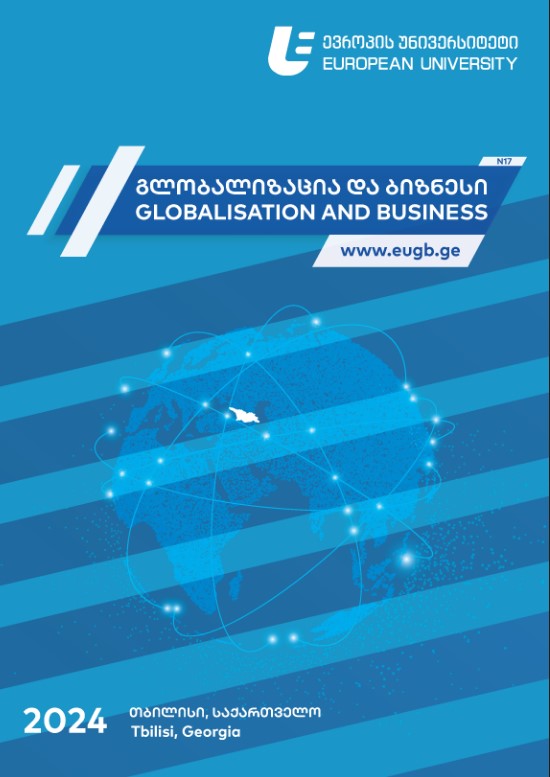Exporting Beekeeping Products: Importance of Detailed Market Analysis and Brand Positioning
DOI:
https://doi.org/10.35945/gb.2024.17.010Keywords:
Beekeeping, Market analysis, Export, Branding, Legal frameworkAbstract
To strengthen the export potential of Georgian bees and intervene in international markets, it is necessary to make a comprehensive and profound analysis. The article discusses the influences of market segmentation, consumers’ preferences, international trading agreements, legal regulations, product certification, technological innovations and competition on the development of marketing and branding strategies, supporting the efficient positioning of the high-quality Georgian bee products on the international markets and increase in export.
Competition evaluation is critical for determining market possibilities and positioning Georgian beekeeping on global markets. The physiological and qualitative functions of the Georgian mountain grey bee must be emphasized: its gentleness, excessive productivity, and resistance to ailments.
The article additionally mentions the importance of a strategic method to boost export capability in integrating technological improvements and contemporary advertising strategies, which include digital technology and database analytics, which will have an instantaneous effect on increasing the charm of beekeeping products. Determining purchaser preferences, cooperation with international organizations and obtaining first-rate certificates are crucial for the global reputation of Georgian beekeeping manufacturers and gaining agreement with customers. Market analysis, contemporary branding, and dynamic marketing are considered the basis for the hit export of Georgian beekeeping products and their established order in international markets.
KEY WORDS: Beekeeping, Market analysis, Export, Branding, Legal framework
Introduction
International markets, with their many opportunities and challenges, require detailed analysis of their complicated mechanisms, especially for a field with unused potential like Georgian beekeepers. International markets, with their multiple opportunities and challenges, require analyzing their complex mechanisms in detail; this is especially true for the Georgian beekeeping sector, which has such untapped potential. A detailed analysis of the international markets is crucial for the potential expansion of Georgian beekeeping exports. Comprehensive analysis is necessary to intervene in those markets and create a niche for quality and unique Georgian bee products.
By exporting of bee products on the international market, market segmentation, study of consumers’ preferences and competitive environment are required, along with the international trading agreements, determining of legislative regulations and product certification criteria and requirements.
A detailed market analysis creates the ground for branding and marketing strategy development, which is directly linked to the increasing export potential of Georgian beekeeping.
Main Text
The importance of the market segments and a detailed understanding of their specific features are highlighted in Begdarashvili’s Master Thesis about Georgia’s export potential. The study of scale and segmentation is the foundation for a detailed market analysis. Each exporting direction has its own unique combination of market dynamics, resulting in individual approaches to product specification, marketing and distribution (Begdarashvili, 2019: 60) [1].
To meet different market demands, understanding consumers’ behaviour, needs, and preferences plays a great role in the selection of bee products. Therefore, the study of consumer preferences is a necessary component of the market analysis. The nature of the consumers’ preferences is dynamic, which is caused by the necessity of meeting the quality of the production, packaging and branding to the market expectations (Giorgashvili, 2020: 35) [2]. Conformity of products to consumer expectations increases market attractiveness and ensures competitive advantage of Georgian beekeeping products.
The legal and regulatory framework is also an important factor for entering the international market and meeting compliance requirements. Each market has its own unique regulatory environment, with specific standards, certificates and legal requirements regulating access to the market and operation. Analysis of the regulatory framework ensures bee products meet the applied requirements. (Nabieva, 2022) [3].
In the global world of beekeeping, competitors use different strategies to occupy market niches and dominate their brands. A detailed study of competitors’ strategies, strengths and weaknesses provides an opportunity to identify market challenges and prospects. It defines the strategic positioning of Georgian beekeeping products, emphasizes their competitive advantages and formulates strategies to strengthen market dominance. (Zhizhiashvili, 2019:22-63) [4].
International trade dynamics are also a defining factor in export potential. A study of the European honey market will clarify the import/export tendencies, rates and the role of trade agreements in developing market potential. Information about trade flows and market access conditions provides the basis for developing trading strategies considering market opportunities and challenges. It identifies potential export destinations, trade partnerships and market diversification opportunities (Achelashvili, 2019: 49) [5].
The role of technological innovations is clear in increasing the international competitiveness of bee products. Technological achievements in production, processing and packaging increase the quality and attractiveness of the product. By promoting innovations, beekeeping products are differentiated in highly competitive international markets. Integrating technologies in product development and marketing increases awareness and attractiveness of products in the market and export potential (Santana De Figueiredo..., 2015) [6].
The relationship between detailed market analysis, marketing and branding strategies and positioning of Georgian beekeeping products on the international market can be schematically expressed as follows:
Chart - The relationship between market analysis and marketing and branding strategies
Source: Chart developed by authors
Proper branding and marketing strategies also play a crucial role in increasing the export potential of Georgian beekeeping products. A comprehensive approach based on empirical evidence and innovative practices is necessary to overcome the complexities of the international market.
Creating a strong brand - product awareness - is crucial. The organic origin of beekeeping products is primely important in shaping consumer choice. When branding Georgian bee products, it is necessary to emphasize their quality and natural origin. Branding should be based on the authenticity of the products, the unique nature of the country, untouched landscapes, the uniqueness of the Georgian Mountain Grey Honeybee and traditional beekeeping methods. (Ceylan..., 2019 [7]; Gencer..., 1999 [8]; Kara..., 2012 [9]; Bokuchava, 2019 [10]).
It is impossible to imagine modern marketing without digital online platforms. They are important for disseminating detailed information. A strategic approach to applying digital marketing tools on a global level, including SEO, social media and “content” marketing, is essential to increase brand awareness. (Hussen, 2023 [11]; Philfan, 2020: 47 [12]).
Understanding consumers’ preferences is also an important marketing task. Taste, brand perception and packaging play an important role in consumer choice. Thus, according to consumer preferences based on market research, adaptation of marketing strategies will contribute to the entry and establishment of Georgian bee products in the international markets.
Cooperation with international organizations and institutions is important for strengthening brand image (Giorgashvili, 2020: 48). International certificates and accreditation verify the product’s quality and safety. In addition, compliance with legal and regulatory frameworks is strategically important to build consumer confidence and facilitate market entry (Bero, 2017) [13].
Integration of innovations in marketing, data analytics, and artificial intelligence are important elements for improving marketing efficiency. It allows the creation of personalized, targeted offers and advertising for the user. Therefore, incorporating technology into marketing strategies is necessary to optimize return on investment (ROI) and expand international access to Georgian beekeeping products. (Novelli..., 2021) [14].
Conclusion
Challenges and opportunities characterise the export potential of Georgian Bee Products. To introduce these products to the international market, it is necessary to analyse the market in accordance with global customer requirements, market segmentation, and competitive environment research. This creates the basis for developing branding and innovative marketing strategies, which determines the attractiveness of Georgian beekeeping products at the international level - forms a unique market niche.
Compliance with international standards and integration of modern technologies in producing and marketing beekeeping products are also strategic necessities. The growing global demand for natural beekeeping products creates a great potential for exporting Georgian beekeeping products in the competitive international market.
Thus, the future success of Georgian beekeeping use of the industry’s export potential depends on implementing marketing strategies developed based on analysing the factors affecting international markets.
References
- Begdarashvili T. (2019). Georgia’s export opportunities and prospects in international trade. Tbilisi. [TSU]. p. 1-82. https://openscience.ge/handle/1/859 [Last Access: 05.10.2023].
- Giorgashvili G. (2020). Modern state system of export support. Tbilisi. [International University of the Caucasus]. p. 35-48. https://openscience.ge/handle/1/1996 [Last Access: 05.10.2023].
- Nabieva, A. R. (2022). Development of the Market for Beekiping Products in the Regions of Russia. Scientific-Theoretical Journal,1, 3–11. https://www.ruc.su/upload/medialibrary/8aa/p9thoixzv3ozy39eigzhjkoo0jsed053.pdf [Last Access: 05.10.2023].
- Zhizhiashvili Z. (2019). Prospects for the export of agricultural products of Georgia to the European Union market. Tbilisi. [TSU]. p.22-63. https://openscience.ge/handle/1/864 [Last Access: 05.10.2023].
- Achelashvili N. (2019). The impact of export diversification on the growth of the country’s economy (on the example of Georgia). Tbilisi. [TSU]. p. 46-61. https://openscience.ge/handle/1/616 [Last Access: 05.10.2023].
- Santana De Figueirêdo, H., & Santana De Figueirêdo Junior, J. H. (2015). Assessment of strategies for value chains using an extended Structure-Conduct-Performance (SCP) framework: an application to the honey business in Brazil. p. 143-145. https://library.wur.nl/WebQuery/wurpubs/492595 [Last Access: 05.10.2023].
- Ceylan, A., Sevin, S., & Ozgenç, O. (2019). Histomorphological and histochemical structure of the midgut and hindgut of the Caucasian honey bee (Apis mellifera caucasia). Turkish Journal of Veterinary and Animal Sciences, 43(6), 747–753. https://doi.org/10.3906/vet-1906-55 [Last Access: 05.10.2023].
- Gencer, H. V., & Firatli, Ç. (1999). Morphological Characteristics of the Central Anatolian (A. m. anatoliaca) and Caucasian (A. m. caucasica) Honey Bees. Turkish Journal of Veterinary & Animal Sciences, 23(7), 107–114. https://journals.tubitak.gov.tr/veterinary/vol23/iss7/17 [Last Access: 05.10.2023].
- Kara, A., Kara, M., & Sezgin, E. (2012). Importance of Caucasian Honeybee and Its Characteristics as a Gene Resource. Journal of Agricultural Science and Technology, 2(10A), 1197–1202. https://www.researchgate.net/publication/290338723 [Last Access: 05.10.2023].
- Bokuchava b. (2019). Statistical analysis of the export of goods from Georgia to EU countries. Tbilisi. [TSU]. p. 14-27. https://openscience.ge/handle/1/782 [Last Access: 05.10.2023].
- Hussen, A. W. (2023). Beekeeping Practices, Challenge and Honey Marketing in West Guji Zone, Oromia Regional State, Ethiopia. Journal of Indigenous Knowledge Development Studies, 5(1), p. 26–48. http://ejol.aau.edu.et/index.php/JIKDS/article/view/8583 [Last Access: 05.10.2023].
- Filfan b. (2020). Georgia’s export potential and the role of marketing in export development. Tbilisi. [International University of the Caucasus]. p. 44-52. https://openscience.ge/handle/1/2044 [Last Access: 05.10.2023].
- Bero, U. (2017). Approaching the Pollinator Problem Through Human-Bee Relations: Perspectives & Strategies in Beekeeping. p. 106-109 http://dx.doi.org/10.20381/ruor-20791[Last Access: 05.10.2023].
- Novelli, S., Vercelli, M., & Ferracini, C. (2021). An Easy Mixed-Method Analysis Tool to Support Rural Development Strategy Decision-Making for Beekeeping. Land, 10(7), 675. https://doi.org/10.3390/land10070675 [Last Access: 05.10.2023].
Downloads
Downloads
Published
Issue
Section
License

This work is licensed under a Creative Commons Attribution-ShareAlike 4.0 International License.









